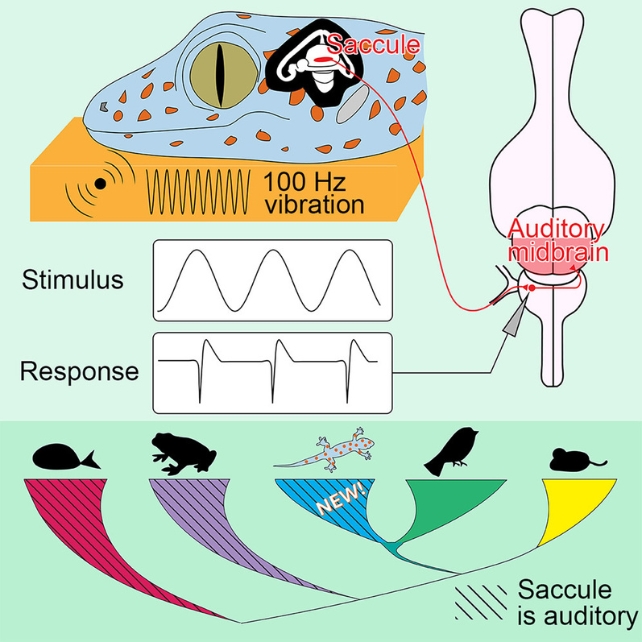ARTICLE AD
 Tokay geckos have been found to have a strange 'sixth sense.' (kuritafsheen/Getty Images)
Tokay geckos have been found to have a strange 'sixth sense.' (kuritafsheen/Getty Images)
Animals have come up with a variety of extraordinary senses worthy of superheroes. Scientists have now discovered that geckos boast a hidden 'sixth sense' that lets them pick up deep, low vibrations.
Like other lizards, tokay geckos (Gekko gecko) have hearing that's specialized towards higher frequency sounds – they're most sensitive between 1,600 and 2,000 Hertz, but can hear beyond 5,000 Hertz.
That's just using their regular old ears, though. Two researchers at the University of Maryland in the US have found that tokay geckos can also use a different structure, not normally associated with hearing, to sense much lower frequency vibrations, in the range of 50 to 200 Hertz.
The saccule is a part of the inner ear that plays a key role in balance and keeping track of head and body positioning. This structure is conserved across fish, amphibians, reptiles, birds, and mammals, but only the first two were known to use it for hearing. Now, it seems at least some reptiles can too.
"The ear, as we know it, hears airborne sound," explains Catherine Carr, biologist and co-author of the new study. "But this ancient inner pathway, which is typically linked to balance, helps geckos detect vibrations that travel through mediums like the ground or water.
This pathway exists in amphibians and fish, and now it's proven to be preserved in lizards as well. Our findings shed light on how the auditory system evolved from what you see in fish to what you see in land animals including humans."
Carr and first author, biologist Dawei Han, closely investigated the brains of tokay geckos, and found that the saccule has a direct connection to a cluster of neurons, called the vestibularis ovalis (VeO), in the hindbrain.
These VeO neurons don't receive input from any other inner ear structures. Information is then passed onto the auditory midbrain, where the animal would perceive the vibrations simultaneously with sound.
To confirm the saccule's role in hearing, the researchers used tungsten electrodes to monitor how VeO units responded to vibrations through a platform. They slowly cranked up the vibes from 10 to 1,000 Hertz, and found that the neurons were most sensitive to frequencies between 50 and 200 Hertz, peaking around 100 Hertz.
Finally, they checked whether the VeO units were just 'hearing' the deep, rumbling sounds produced by the vibration device via typical auditory channels. The team delivered sound stimuli to the animals' ears, at the same frequencies but louder volume – and sure enough, they didn't detect any response from the VeO units.
 Illustration of the experimental setup and findings. (Han and Carr, Cell Reports, 2024)
Illustration of the experimental setup and findings. (Han and Carr, Cell Reports, 2024)This makes the tokay gecko the first amniote (the clade comprising all reptiles, birds, and mammals) known to use the saccule for this purpose.
That said, they haven't found an obvious behavioral reason for these lizards to have dedicated vibration receptors in their heads yet. Tokay geckos are notoriously noisy creatures, and their loud calls are well inside the frequency range of their regular hearing. But Han and Carr hypothesize they might use it to detect low rumbles from incoming wind, rain, and predators.
And it might not be alone – a cursory survey revealed structures that look like VeO in a few other lizard and snake species, suggesting the superpower might be relatively widespread in reptiles. Further study will be needed to confirm that, the team says.
There's no love for us mammals, though. Our saccule/hindbrain connections are far weaker, and it's thought they mainly play roles in suppressing self-generated sounds and tracking our head position. But for reptiles, this sixth sense could help them in a range of ways.
"A lot of snakes and lizards were thought to be 'mute' or 'deaf' in the sense that they do not vocalize sounds or hear sounds well," says Han.
"But it turns out they could potentially be communicating via vibrational signals using this sensory pathway instead, which really changes the way scientists have thought about animal perception overall."
The research was published in the journal Cell Reports.

 1 month ago
21
1 month ago
21 

